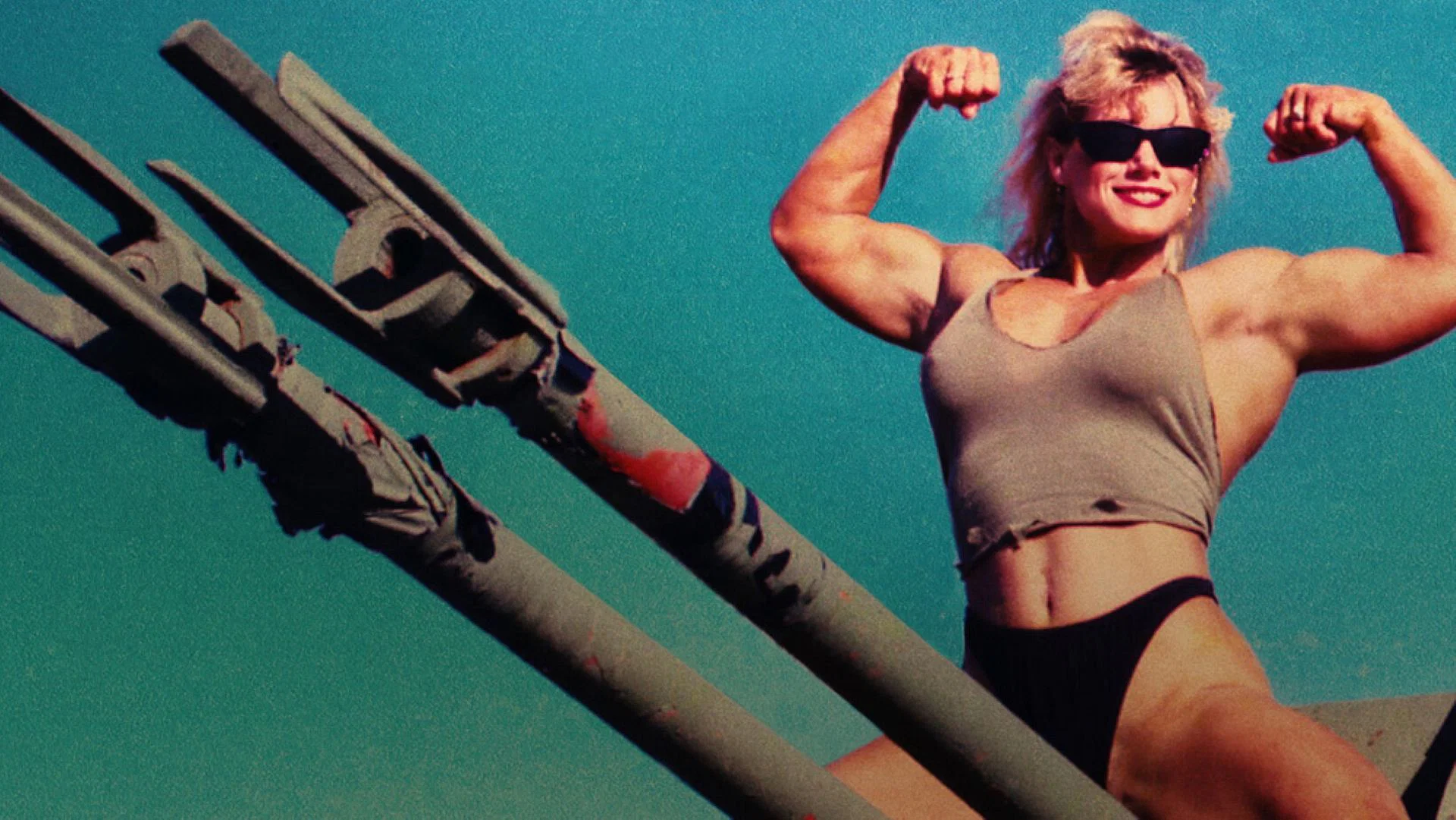Killer Sally, a new Netflix true crime docuseries, begins as many in the genre do: with a death and the tape of a 911 call. We hear Sally McNeil’s voice, shaky but steadfast, answering the operator in Oceanside, California, with clipped statements: she just shot her husband because he was beating her. The wailing voice in the background is her daughter. Her husband of eight years, bodybuilding champion Ray McNeil, is on the ground but still breathing.
Killer Sally never disputes these facts, nor the fact that Sally shot Ray twice – once in the abdomen, once in the face – with a gun she had purchased, killing him on Valentine’s Day, 1995. The three-part series, directed by Nanette Burstein (Hillary) is less an investigation into what happened that evening than a detailed parsing of how the legal system, and the media at large, handled McNeil’s case – as a member of the misunderstood subculture of bodybuilding, as a victim of prolonged domestic abuse, as a muscular, undeniably buff woman who prosecutors argued was “too strong to be battered”.
That handling was, unsurprisingly, not sensitive. McNeil was arrested and charged with murder. Her two children, nine and 11 at the time, were sent to a shelter, then across the country to live with their grandmother in McNeil’s home town of Allentown, Pennsylvania. The press labeled Sally McNeil, a former marine and amateur bodybuilder who moonlit as a wrestler for direct-to-home videos, the “pumped up princess”, a “brawny bride”.
Her case drew national attention on the heels of several high-profile trials involving domestic violence and/or the cultural specter of the “angry woman”: the OJ Simpson trial in 1995, in which Simpson was acquitted of the murder of his wife, Nicole Brown Simpson, who he physically abused; Tonya Harding’s connection to the assault on rival figure skater Nancy Kerrigan in 1994; Lorena Bobbitt’s 1994 trial for cutting off her abusive husband’s penis. All three have been the subject of contemporary cultural reconsiderations – the Simpson trial in Ezra Edelman’s superb 2016 docuseries OJ: Made in America, Harding in the 2018 film I, Tonya, and Bobbitt in the 2019 Amazon series Lorena.
“I have no interest in gratuitous true crime,” Burstein, who also directed a 2014 ESPN 30 for 30 episode on Harding, said, responding to concerns over the genre’s tendency to exploit rather than explore. McNeil’s case, like Harding’s and the Simpson trial and other high-profile crime stories of the 90s, act as a prism for larger societal issues then and now. “That is what really attracted me to the story – it was really about domestic violence, and it’s about gender roles,” she said.
“It’s really about other women, because this is still happening today” with numerous examples of criminalized and incarcerated survivors of abuse who claimed self-defense. Though there is no official tracking for the rate of this criminalization, evidence suggests that domestic violence contributes to incarceration in direct and indirect ways; a 2016 study by the Vera Institute of Justice found that 77% of women in US jails were survivors of intimate partner violence.
Killer Sally thus offers McNeil a familiar contemporary revision, examining how the legal system was unprepared for and unsympathetic to the insidious effects of sustained domestic abuse, especially from a woman who presented as physically strong. How a prosecution team could successfully twist her self-defense arguments and inconsistencies into a conviction for second-degree murder, with a sentence of 19 years to life. How intimate partner violence ingratiates, degrades and perpetuates, largely told in McNeil’s own words in several sit-down interviews.
The three episodes trace, mostly chronologically, Sally McNeil’s simultaneous paths into amateur bodybuilding in the 1980s and into a whirlwind romance with Ray McNeil. Beaten both by her stepfather and her first husband, Sally found respite through sports – diving, cross-country – and, in her 20s, bodybuilding. She met Ray McNeil in a gym, which she describes as “lust at first sight”. On the outside, the two were a photogenic bodybuilding power couple, stand-outs in the crowd – interracial (Sally is white, Ray was black), clad in tight gym gear, a parade of muscles, both passionate about the pursuit of aesthetic idealism through intense training and control of the human body.
The series takes its name from Sally’s stage moniker, which she adopted as a means to make money to support Ray’s fledging professional career and the illicit “supplements” – steroids – required to remain competitive. Sally could make up to $300 an hour from so-called “muscle prostitution”, in which she would wrestle men in hotel rooms or on mail-order videos. In the year 1993, she says, she spent $24,000 from her own career, however seedy and stigmatized, on Ray’s bodybuilding pursuits.
The financial strain dovetailed with increasing volatility at home. McNeil and her two now-adult children, Shantina and John, recall routine beatings by Ray, beginning shortly after the McNeils’ wedding in 1987. Three days into their marriage, she says, Ray punched her in the face, cracking her lip. Sally says Ray, who had at least 100lb of muscle on her, often choked her; Shantina remembers the sound of her mother gasping for air. Ray once broke Sally’s nose in front of her children; she filed a report, which went nowhere after Ray beat her until she promised to recant. In a devastating piece of footage from the police interrogation room on the night of Ray’s death, McNeil’s children try to reassure her that everything is going to be OK – “if you thought [he] was gonna kill you then that’s self-defense,” says John, a fourth-grader.
The final hour of the series focuses on McNeil’s 1996 trial, including the prosecution’s argument that McNeil’s reloading of the gun before the second shot evinced premeditated intent. “You look at a case like this, and you do have to wonder about somebody’s innocence or guilt, just like the jury had to wonder this. So it’s important to present the strong argument that the prosecution was making,” said Burstein. “But some of it was also pointing out how inane some of the argument was, that she couldn’t have possibly been a victim because she was too strong. Which is absurd.”
Evidence deemed admissible to the court, especially after McNeil testified in an attempt to explain her own story, included the cover to a video she made in character as a wrestler – “Killer Sally” holding the same shotgun she would later wield against Ray. “That was not evidence, and yet it was probably one of the more damaging things presented to the jury,” said Burstein. “The trauma that she had and her children had and how you react in those situations was not sensitively discussed [in the trial]” and was “definitely undermined by the prosecution”.
Jurors’ subjective processing based on sexist biases, such as the idea that Sally could not be a battered woman because she was (in costume) a muscular, man-destroying killer, is “not just exclusive to the 90s or beforehand”, said Burstein. “That’s still the case today, unfortunately.”
Ultimately, as in many other cases, McNeil’s legal defense of so-called “battered woman syndrome”, now understood as a subset of post-traumatic stress disorder from intimate partner violence, did not work. She served nearly 25 years in prison. The final act of the series plays like a moving postscript to a life and family still in flux, in recovery – dogged by cycles of abuse and violence and strained relationships made worse by a punitive justice system; looking ahead to what could and should be a better future.
![]()
![]()


